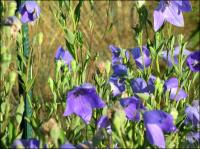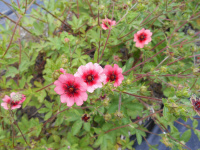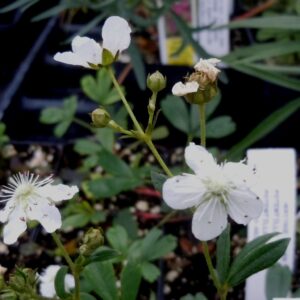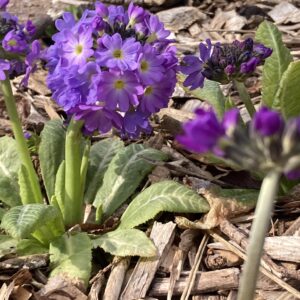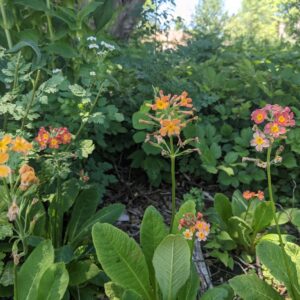Plants for Butterflies and Other Pollinators
Showing 137–144 of 211 results
-
Platycodon grandiflorus Balloon flower Z 3-9
Balloon shaped buds as though puffed with air, open to blue, five-petal bells from mid-summer to early fall.
Balloon shaped buds as though puffed with air, open to blue, five-petal bells from mid-summer to early fall.
Size: 24" x 12"
Care: Sun to part shade in moist well-drained soil, heat and drought tolerant. Deadhead for rebloom.
Native: Eastern Asia
Wildlife Value: attracts butterflies, bees & hummingbirds
Awards: Received England’s Royal Horticultural Society Award of Merit.Platycodon is Greek from platys meaning “broad” and kodon meaning “bell”, referring to the shape of the flower. Cultivated in China for hundreds of years where it is called Jie-geng. The Chinese used the root boiled to cure a chill in the stomach. Mentioned in Man’yoshu, a Japanese anthology of poems written in the 8th century. German botanist Johann Gmelin first discovered P. grandiflorus in Siberia in 1754. Gmelin’s Siberian mission, sponsored by Catherine the Great, took 10 years and nearly killed him. Gmelin introduced it to European garden cultivation by 1782. Cultivated in the U.S. since the 1800’s.
-
Polemonium brandegeei Brandegee’ Jacobs-ladder, Yellow sky pilot Z 4-8
Hanging, tubular yellow, sometimes white blooms over frilly foliage, May-July
OUT OF STOCK
Hanging, tubular yellow, sometimes white blooms over frilly foliage, May-July
Size: 8” x 10”
Care: sun to part shade in very well-drained soil
Native: CO, NM, SD, UT, WY
Wildlife Value: attracts bees, butterflies & mothsCollected by Townshend Stith Brandegee in the ‘Valley of the Rio Grande, on the Los Pinos Trail’ c. 1870. Brandegee then sent it to Harvard botanist Asa Gray who identified and named it to honor its collector.
-
Polemonium reptans Greek valerian, Jacobs ladder Z 3-8
Opposite leaves grow up the foot-tall stems forming a ladder to the tops where sprays of five-petaled lavender-blue bells with bright yellow stamens, bloom in spring. Repeats if deadheaded and may self-sow if not cut back.
Opposite leaves grow up the foot-tall stems forming a ladder to the tops where sprays of five-petaled lavender-blue bells with bright yellow stamens, bloom in spring. Repeats if deadheaded and may self-sow if not cut back.
Size: 8-12” x 10”
Care: part shade in moist to moist well-drained soil
Native: Ontario & Quebec to Alabama, west to MN & KS, Wisconsin native
Wildlife Value: attracts bees, butterflies and wasps. Tolerates walnut, resists deer.Polemonium is Greek meaning “to wage war,” “on account of the contests, which arose betwixt two princes, each assuming the honour of the discovery of it to himself.” Gardeners Dictionary, 1768. Meskwaki made a compound of roots of this plant as a physic and urinary problem remedy. Collected for gardens before 1750.
-
Potentilla atrosanguinea Himalayan cinquefoil Z 5-8
Open pink cups in June-July
Open pink cups in June-July
Size: 18-24" x 24"
Care: Sun well-drained soil
Native: HimalayasPotentilla is Latin meaning powerful referring to medicinal properties. Potentillas used by dentists in the 16th century to reduce pain according to Gerard, English herbalist. Per Culpepper, 17th century English herbalist potentilla is to be used if Jupiter is ascending and the moon is “applying to him.” Atrosanguinea 1st collected in its native Nepal in 1822.
-
Potentilla tridentata syn. Sibbaldiopsis tridentate Three-toothed cinquefoil Z 2-7
Clusters of white, single rose-like saucer flowers spring and early summer on this dainty-appearing perennial. Its glossy evergreen leaves tinge red in fall and winter.
Clusters of white, single rose-like saucer flowers spring and early summer on this dainty-appearing perennial. Its glossy evergreen leaves tinge red in fall and winter.
Size: 6" x 12" spreading by runners-can become a groundcover.
Care: sun in well-drained to moist well-drained acidic soil.
Native: New England to Upper Great Lakes, north to the Arctic, Appalachian Mountains of Georgia, Wisconsin native.
Awards: Cary Award Distinctive Plants for New EnglandDescribed by Kew’ Botanic Garden’s 1st botanist William Aiton (1731-1793) Hortus Kewensis vol 2 p. 216 (1789), who wrote that it came from Benjamin Bewick’s “curious botanic garden” in Clapham. Introduced it in 1776.
-
Primula beesiana Candelabra primrose, Bee’s primrose Z 4-8
From 2-8 stems, each bearing a whorl of a dozen or so small, fuchsia-pink flowers encircling each leafless stem like a ballerina’s tutu,, then alternating with a leafless stem, the another whorl of flowers then another section of leafless stem in tiers, Each whorl blooms in succession from the bottom up.
From 2-8 stems, each bearing a whorl of a dozen or so small, fuchsia-pink flowers encircling each leafless stem like a ballerina’s tutu,, then alternating with a leafless stem, the another whorl of flowers then another section of leafless stem in tiers, Each whorl blooms in succession from the bottom up.
Size: 1’ x 1’
Care: part shade in moist or moist well-drained soil in neutral to acidic pH
Native: Sichuan and Yunnan provinces in SW China and Myranmar
Wildlife Value: attracts butterflies, bees and other pollinators
Awards: Royal Horticultural Society Award of Garden MeritPrimula means “first spring” in Italian. The common name “Bee’s” is not for the insect; it’s for the nursery that grew them on and sold them and funded Scottish collector George Forrest’s trip to China to hunt for plants. Forrest collected this around 1910. Naturalist Arthur Bulley (1861-1942) owned that nursery, Bees Ltd.
-
Primula denticulata Drumstick primula Z 3-8
A ball of flowers, like a lollipop, purple or blue with a yellow eye, atop each leafless stem, emerging from a base of wrinkled foliage. Flowers in spring.
A ball of flowers, like a lollipop, purple or blue with a yellow eye, atop each leafless stem, emerging from a base of wrinkled foliage. Flowers in spring.
Size: 12-18" x 12-18"
Care: Sun to shade in moist to moist well-drained soil.
Native: Afghanistan, N. Pakistan, across the Himalaya to Yunnan, Sichuan and Guizhou in China.Collected by Dr. Frances Buchanan “in moist hills about Chitlong in Nepal.” Exotic Botany, vol. 2 (1805), Sir James Edward Smith (1759-1828).
-
Primula x bulleesiana Candelabra primrose Z 4-7
From clustered stems, each bearing a whorl of 3-6 flowers encircling each leafless stem alternating with a bare section of leafless stem, then another whorl of flowers, then another section of bare stem, in tiers, like a ballerina’s tutu with bare midriff between. Each whorl blooms in succession from the bottom up. This blooms June – July in a rainbow of colors - red, orange, rose, cream, lavender and purple.
OUT OF STOCK
From clustered stems, each bearing a whorl of 3-6 flowers encircling each leafless stem alternating with a bare section of leafless stem, then another whorl of flowers, then another section of bare stem, in tiers, like a ballerina’s tutu with bare midriff between. Each whorl blooms in succession from the bottom up. This blooms June – July in a rainbow of colors – red, orange, rose, cream, lavender and purple.
Size: 18-24” x 12-18”
Care: Sun to part shade in moist to well-drained soil
Wildlife Value: Attracts butterflies. Deer resistant
Awards: Royal Horticultural Society Award of Garden Merit 1993Hybrid cross between Primula bulleyana and Primula beesiana (both parents are native to the Himalayas and China).
Collected in China, introduced to Britain in 1906

